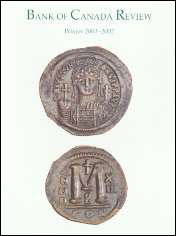Bank of Canada Review - Winter 2001–2002
Cover page
Byzantine 40-Nummi Piece
The 40-nummi piece was the largest and heaviest copper coin minted under Justinian. About the size of an old Canadian silver dollar, it weighs 22.76 grams. It was struck in Constantinople (now Istanbul), the capital of the Byzantine Empire and is part of the National Currency Collection, Bank of Canada.
Photography by James Zagon, Ottawa.
